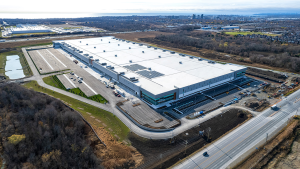The Canada Green Building Council (CaGBC) and WSP say they have compiled a strong business case that striving for zero carbon status in new buildings can deliver profitable returns compared to building to Canada’s existing energy code.
Their recent paper, Making the Case for Building to Zero Carbon, studied seven building types and applied a tailored package of carbon reduction measures including wall and roof enhancements, window upgrades, enhanced user (smart) controls, efficient ventilation systems, better heating and cooling delivery systems, fuel switching and the use of onsite renewable power to compare capital costs and life cycle returns for zero carbon building (ZCB) with those associated with the 2011 energy code.
Mark Hutchinson, vice-president of green building programs and innovation for the CaGBC and Antoni Paleshi, practice leader of WSP’s Canadian Building Performance Analysis Team, outlined the study results to a CaGBC webinar audience June 12.
“The question is not can we build zero carbon buildings but can we do it cost effectively,” Hutchison said. “The return at the end of 25 years was a net present value of one per cent increase relative to the base case.
“ZCB is technically feasible and financially viable today. It is a very exciting point in time. We are at a tipping point.”
The one per cent returns, inclusive of carbon pollution pricing, represented the average across seven building types.
Mid-rise and low-rise offices offer the highest life cycle returns at close to three per cent, while warehouses and big box retail facilities can give returns of one to two per cent and multi-unit residential buildings and primary schools are close to cost neutral.
“At the end of the day, no archetype fell off the table and did not make sense,” Hutchinson said.
ZCB is defined as a building that is “highly energy-efficient and produces onsite, or procures, carbon-free renewable energy in an amount sufficient to offset the annual carbon emissions associated with operations.”
The ZCB standard was unveiled by the CaGBC in 2017.
The business case study, released in February, assessed building to zero carbon in Vancouver, Calgary, Ottawa, Toronto, Montreal and Halifax. The paper argues, “By turning existing and new buildings into ZCBs, Canada can significantly reduce its GHG emissions, decrease the demand for carbon intensive energy and support Canadian real estate owners in optimizing the returns and resiliency of their portfolios.”
Since ZCB is still relatively new in Canada, it is not yet well understood by the development and construction industries, the paper suggested.
In Montreal, Ottawa, Toronto and Calgary, the outcomes for ZCBs are economically strong
— Mark Hutchinson
Canada Green Building Council
The study found the incremental capital cost to build to ZCB was eight per cent or $253 per square metre.
The annual operating savings cost was 24 per cent, or $17 per square metre.
“That is how you slowly eat away at the investments in the building and end up with the positive investment,” Hutchison explained.
Regionally, the paper reported, the outcomes for ZCBs are strongest in Halifax due to the high carbon intensity of the Nova Scotia electricity grid.
“In Montreal, Ottawa, Toronto and Calgary, the outcomes for ZCBs are economically strong with any upfront capital cost premium mitigated over the life cycle by higher operating and emissions savings,” the report explained.
The report noted that the incremental capital cost for developing ZCBs is expected to come down over time as building codes are strengthened and the price of carbon pollution increases.
Hutchison noted that the current federal carbon pricing schedule sees the cost rising to $50 per tonne in 2022.
The report makes the assumption there will be an annual increase of $8 per year over 25 years, making for an average cost of carbon pollution of $150/tonne.
Paleshi offered technical insights into the implementation of the various carbon-reduction measures studied in the report during the webinar, explaining, for example, how user-controlled loads could include measures as simple of opening and closing windows.
Equally simply, user feedback on temperature comfort can be another valuable input.
“Activity-based workplaces are an important movement,” Paleshi explained.
He also advocated that extensive attention be paid to whole-building R values including glazing, roofs, walls and windows to maximize savings.
“Sweat the small stuff,” Paleshi urged.
Hutchison told the webinar audience that even if owners are not prepared to commit to full ZCB in a new building, it’s still worthwhile to plan for a day when the structure can be adapted to that standard.
“If you can’t do it now, plan for the future, and incorporate measures that will be hard to incorporate in the future,” he said.
Owners can set the tone for a ZCB project, Hutchison said, by becoming fully engaged in their projects.
“Sometimes you have to challenge the design team to go outside of their comfort zone, and to improve upon the standards in this study,” he said.
“You need to choose the right team and you need to engage them as early as possible in the process that is critical to success.”











Recent Comments
comments for this post are closed